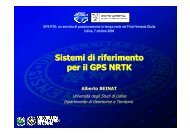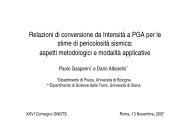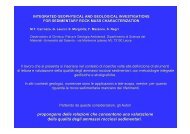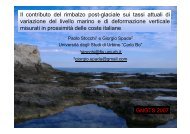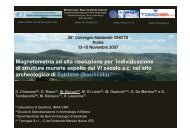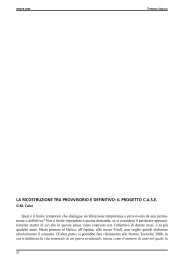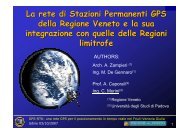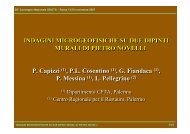You also want an ePaper? Increase the reach of your titles
YUMPU automatically turns print PDFs into web optimized ePapers that Google loves.
GNGTS 2009 SESSIONE <strong>2.3</strong><br />
Fig. 4 - Comparison<br />
between the results<br />
obtained by the low<br />
and high frequency<br />
simulations in terms<br />
of PGA and PGV<br />
assuming different<br />
hypocentre locations<br />
for each fault: a)<br />
Western Liguria; b)<br />
Western Alps; c)<br />
Monferrato.<br />
kinematic rupture with a rake angle of 135 degree and the hypocentre represented by a star in Fig.<br />
3 yields the worst shaking scenario illustrated in Fig. 3. The Fourier spectra obtained by the two<br />
procedures are complementary, with a range of superimposition between 0.2 and 0.6 Hz. After this<br />
range, GRFLT12S results start to decay significantly. The S-waves contributions computed by the<br />
two methods are in agreement, both in terms of wave arrival and peak amplitude. In terms of time<br />
histories, while in the GRFLT12S traces the arrivals of P and S waves can be clearly distinguished,<br />
EXSIM reproduces the S waves only, as expected.<br />
A total of 144 low frequency and 50 high frequency simulations have been computed to define<br />
the deterministic worst ground shaking scenarios. In Fig. 4 the numerical results are summarised in<br />
terms of horizontal Peak Ground Acceleration (PGA) and Peak Ground Velocity (PGV) relative to<br />
the worst scenarios computed for each fault, assuming different hypocentre locations. As expected,<br />
high frequency simulations predict larger values of ground shaking if compared with the low frequency<br />
results. The difference of the ground motion parameters estimated by the two methods<br />
increases by increasing the magnitude of the event. GRFLT12S correctly simulates the directivity<br />
effects, ignored by EXSIM. The Western Liguria event generates the largest PGA and PGV values<br />
of 0.06 g and 0.065 m/s respectively. Similar values of maximum PGV of ~0.02 m/s and PGA of<br />
~0.02 g have been calculated for both the Western Alps and Monferrato events.<br />
Acknowledgements. The present contribution has been developed in the framework the research contract<br />
undersigned with the Administration of Vicoforte Sanctuary for the monitoring and survey of the “Monte<br />
Regalis Basilica”, with the support of the Fondazione Cassa di Risparmio di Cuneo. The authors would like to<br />
extend their gratitude to Prof. Mario Alberto Chiorino, Coordinator of the Program (Politecnico di Torino) and<br />
to the Administration of the Sanctuary.<br />
References.<br />
Hisada Y. & Bielak J. [2003], A theoretical method for computing near fault ground motion in a layered half-spaces considering<br />
static offset due a surface faulting, with a physical interpretation of fling step and rupture directivity, Bull. Seism. Soc. Am,.<br />
93 (3), 1154-1168.<br />
Lai C.G, Corigliano M., Sánchez H., Scandella L. [2009], Definition of seismic input at the “Regina Montis Regalis” Basilica of<br />
Vicoforte, Northern Italy, in press by IUSS press<br />
Motazedian D. and Atkinson, G. [2005], Stochastic Finite-Fault Modeling Based on a Dynamic Corner Frequency, Bulletin of the<br />
Seismological Society of America, 995-1010.<br />
489




